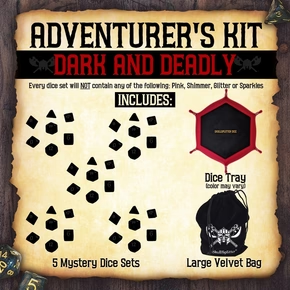
DM’s Guide to Running Aquatic and Seafaring Campaigns for DND 5e
Diving In: DM’s Guide to Running Aquatic and Seafaring Campaigns in Dungeons and Dragons
With "Ghosts of Saltmarsh" hot off the presses, a ton of new aquatic adventures are just about to splash down. But some veteran players will balk at the idea of a campaign that takes place mostly or partially underwater.
Table of Contents:

It's like the dreaded water temple, there's a few pitfalls that can really spoil an aquatic campaign and make it painful to play or run. With just a few helpful tips, you can make sure your next aquatic adventure sails ahead without taking on water.
Adventuring Below the Waves
Pirates, krakens, long lost temples to Lovecraftian horrors, there’s a lot of interesting places you can take your players so let’s start tackling the obstacles standing in your way.
Firstly, assuming your party isn’t entirely tritons (though that could be fun) you’ll need to figure out how you’ll be handling this whole “breathing underwater” issue. If you plan on a primarily nautical campaign above the water, then you can just let your players address it with the rules as written. Situations that require water breathing will tax your spellcasters a bit, or they’ll simply invest in some magic items.
If you plan on regular underwater adventuring, you’ll have to provide them with the needed magic items or some similar macguffins. You can go about this in 2 ways.
If you want a campaign in which diving into the depths still feels dangerous, limit the amount of breathing time your water breathing macguffins provide. This will help cut down on faffing about and it will make every dive a bit more stressful, even if the time limits never really get pressed upon.
Or, if you want to have Atlantis style sea-bottom living, make your water breathing macguffins easy and risk-free. There’s a lot to be gained from roleplaying extended stays underwater and all the odd inconveniences it brings.
However you go about it, just make sure that you keep tabs on how well your party can fare if they all go overboard.
Ship Combat is Finally Fun!
The new Ghosts of Saltmarsh book for 5e D&D has filled in a so far missing element from our 5e campaigns, an official set of rules for ships and other vehicles. We already know that they plan on using these rules for all vehicles moving forward so it’s a great idea to get familiar with them.
Firstly, vehicles now get their own stat block, including all the ability scores that a creature has (though with typically 0 in Wisdom, Intelligence, and Charisma). This simplifies a lot of interactions that were before quite problematic. The primary sections of each ship have been divided into “components”, each with their own total hit points, their AC, and a fancy new attribute called a “damage threshold”.
Don’t confuse a damage threshold for a DR or damage resistance. A damage threshold specifies a minimum amount of damage needed to actually damage something. If damage dealt to an object doesn’t pass the damage threshold, it doesn’t do any damage. This doesn’t reduce the damage if you pass the threshold like damage resistance would.
Say the hull of your ship has a damage threshold of 10. An attack that deals 9 damage to the hull instead deals 0 damage, because it was lower than the damage threshold. An attack that deals 11 damage deals the full 11 damage, because it was higher than the damage threshold.
Crewing ships has been streamlined and trimmed down from previous editions. It cleans up most of the rules minutia and just lets your players start shouting “full speed ahead” as they captain a vessel. You can now let your players take on specific roles on a ship such as captain, bosun, or first mate, which all have special actions they can take while amid ship on ship combat. One of the primary problems with ship combat throughout multiple editions was the loss of player agency and “uniqueness” while serving the needs of a vessel. These new rules go quite far towards bringing that player agency back. And for you as a DM, you can stop worrying about the stats of dozens of crew members, that whole issue got rather cleaned up.
3D Combat

Where most DMs get tripped up the most with aquatic campaigns is the combat. Unlike most combats that occur on a nice flat 2D plane, almost all encounters that occur underwater will have to deal with that troublesome 3rd dimension.
Underwater combat is just more complicated, you can’t get around it but you can definitely make it easier on yourself.
The easiest way to think of underwater combat is to think of all of your players and monsters as flying. That is to say, use the same tricks for representing swimming creatures as you would for flying creatures.
If you have a visible bottom to the area your players are swimming in, treat that seabottom as the ground and keep track of how many feet above that bottom each creature is swimming. If you’re using miniatures, flying stands work well for representing this, or you can use the old standby of standing your minis up on dice boxes.
If you are out in the open ocean or some similar area where the bottom is leagues away, instead think of the surface of the water as the “ground”. Keep track of how many feet below the surface each creature is, just as if the creatures were “flying below” the surface. I like to cover miniatures with a dice box when they submerge like this, but any clear indication works.
Sadly, this all gets further confounded when creatures start swimming above and below each other. Representing these board states can get really tricky, but whatever way you indicate your minis are “sharing spaces” just make it clear to your players. When multiple creatures share a “space” by swimming above and below each other, I like to remove both minis and place a die there showing the number of creatures in that “space”.
Overall, you may find that in underwater combats, the more open the space gets the more confused players become. We like to always keep some kind of reference point or landmark clearly visible for your players, especially if you’re playing without minis in the “theater of the mind”. Having a ship or ruin nearby makes it easier to identify that the shark is “20 feet from the bottom of the ship” rather than “20 feet over that way”.
Also keep in mind your player’s freedom of movement underwater when you design their encounters. If you want to constrict your player’s path through a dungeon (boss at the end, etc.) you’ll need to place it within a sea-cave or similarly enclosed area. Swimming players will likely start at the top and work their way down, so make sure you place your intended final rooms deep within your structures, rather than at the tops of towers or similar heights.
Open Oceans
A rather unexpected consequence that I and other DM’s have felt in nautical adventures is a feeling of harsh railroading. Your first thought would be the opposite, the players have a ship and can go anywhere, ideal sandbox territory right? Well, sort of.
Say the players are on a quest that takes them to a specific island. Unless you place something in the way as a specific hindrance, the players are likely to simply sail to their destination without encountering anything else. Especially in charted waters, there’s not a lot of logical reasons for exploration unless you create the reasons.
Open ocean has a lot of empty space in it and big nautical campaigns can really suffer from empty world syndrome, with lots of wide empty areas that just turn into a string of railroaded encounters.
I highly recommend creating dynamic maps and using exploration rules while running a nautical campaign. Create storms that move naturally as the players move, possibly blocking travel or creating a disturbance depending on where your players go. Have other vessels travel along their courses, intersecting the players only if they happen upon them. Have numerous points of interest that your players can choose to investigate or leave behind.
Also, now with clear rules for crewing ships, you as DMs have been given one of the greatest gifts, dozens of NPCs that travel with the party! These nameless, faceless crew members can become interesting side-quests or memorable NPCs at a moment’s notice! Need a lead to the bad guy’s lair? Good thing your deck-swab was raised on the BBEG’s island. Need to get your party into conflict? Good thing that midshipman was actually a spy for the pirates this whole time!
We also recommend keeping track of supplies (or at least better track than normal). You shouldn’t be counting every scrap of hard-tack, but dynamically using supplies can force your players to make port, resupply in strange locales and generally have more of an adventure rather than just bee-lining it for the quest objective.
We realize all that is a lot of work, but believe me, nautical campaigns will be so much more memorable when your players can really feel like they’re exploring uncharted waters and making discoveries rather than just being strung along between encounters.
Enjoy this Guide? You May Also Like:
Thinking about other classes? Check out our giant list of D&D 5e Tools and Tips here.
Hungry for Adventure? Your group will love these D&D Game Night Snack Recipes
New to find a D&D Group? Check out our guide on How to Find a D&D Group.
Space Hamsters? Ooze PCs? Check out our Spelljammer Adventures in Space review
Disclaimer
Last updated: January 27, 2019
The information contained on www.SkullSplitterDice.com website (the "Service") is for general information purposes only.
Blueshift Nine, LLC assumes no responsibility for errors or omissions in the contents on the Service.
In no event shall Blueshift Nine, LLC be liable for any special, direct, indirect, consequential, or incidental damages or any damages whatsoever, whether in an action of contract, negligence or other tort, arising out of or in connection with the use of the Service or the contents of the Service. Blueshift Nine, LLC reserves the right to make additions, deletions, or modification to the contents on the Service at any time without prior notice.
Blueshift Nine, LLC does not warrant that the Service is free of viruses or other harmful components.
Affiliate disclaimer
This affiliate disclosure details the affiliate relationships of Blueshift Nine, LLC with other companies and products.
Some of the links are "affiliate links", a link with a special tracking code. This means if you click on an affiliate link and purchase the item, we will receive an affiliate commission.
The price of the item is the same whether it is an affiliate link or not. Regardless, we only recommend products or services we believe will add value to our readers.
By using the affiliate links, you are helping support the Service, and we genuinely appreciate your support.
Affiliate advertising programs that the Service uses are:
- Amazon Services LLC Associates Program
- As an Amazon Associate, I earn from qualifying purchases.
- Blueshift Nine, LLC is a participant in the Amazon Services LLC Associates Program, an affiliate advertising program designed to provide a means for sites to earn advertising fees by advertising and linking to Amazon.com or endless.com, MYHABIT.com, SmallParts.com, or AmazonWireless.com.
- Pages on this Service may include affiliate links to Amazon and its affiliate sites on which the owner of this Service, Blueshift Nine, LLC, will make a referral commission.

Disclaimer
Last updated: January 27, 2019
The information contained on www.SkullSplitterDice.com website (the "Service") is for general information purposes only.
www.SkullSplitterDice.com is a participant in the Amazon Services LLC Associates Program, an affiliate advertising program designed to provide a means for sites to earn advertising fees by advertising and linking to Amazon.com. (source: Section 5)
Blueshift Nine, LLC assumes no responsibility for errors or omissions in the contents on the Service.
In no event shall Blueshift Nine, LLC be liable for any special, direct, indirect, consequential, or incidental damages or any damages whatsoever, whether in an action of contract, negligence or other tort, arising out of or in connection with the use of the Service or the contents of the Service. Blueshift Nine, LLC reserves the right to make additions, deletions, or modification to the contents on the Service at any time without prior notice.
Blueshift Nine, LLC does not warrant that the Service is free of viruses or other harmful components.
Affiliate disclaimer
This affiliate disclosure details the affiliate relationships of Blueshift Nine, LLC with other companies and products.
Some of the links are "affiliate links", a link with a special tracking code. This means if you click on an affiliate link and purchase the item, we will receive an affiliate commission.
The price of the item is the same whether it is an affiliate link or not. Regardless, we only recommend products or services we believe will add value to our readers.
By using the affiliate links, you are helping support the Service, and we genuinely appreciate your support.
Affiliate advertising programs that the Service uses are:
- Amazon Services LLC Associates Program
- As an Amazon Associate, I earn from qualifying purchases.
- Blueshift Nine, LLC is a participant in the Amazon Services LLC Associates Program, an affiliate advertising program designed to provide a means for sites to earn advertising fees by advertising and linking to Amazon.com or endless.com, MYHABIT.com, SmallParts.com, or AmazonWireless.com.
- Pages on this Service may include affiliate links to Amazon and its affiliate sites on which the owner of this Service, Blueshift Nine, LLC, will make a referral commission.

